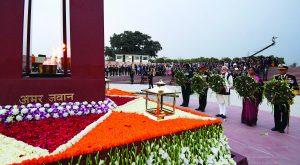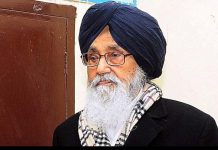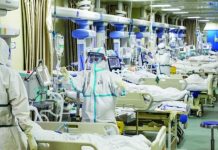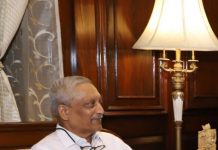 The National War Memorial was dedicated to the nation when the Prime Minister, Narendra Modi, lit the eternal flame, to mark the dedication of the National War Memorial in New Delhi, to the nation on February 25. He called it the symbol of sacrifice and courage of soldiers. Spread over an area of 40 acres, the memorial consists of four circles- the ‘Amar Chakra’, ‘Veerta Chakra’, ‘Tyag Chakra’ and the ‘Rakshak Chakra’ and has the names of 25,942 soldiers inscribed in golden letters on granite.
The National War Memorial was dedicated to the nation when the Prime Minister, Narendra Modi, lit the eternal flame, to mark the dedication of the National War Memorial in New Delhi, to the nation on February 25. He called it the symbol of sacrifice and courage of soldiers. Spread over an area of 40 acres, the memorial consists of four circles- the ‘Amar Chakra’, ‘Veerta Chakra’, ‘Tyag Chakra’ and the ‘Rakshak Chakra’ and has the names of 25,942 soldiers inscribed in golden letters on granite.
Accompanied by Defence Minister Nirmala Sitharaman and three service chiefs- Army chief Gen Bipin Rawat, Air Chief Marshal B S Dhanoa and Navy Chief Admiral Sunil Lamba, PM Modi took a tour of the memorial. “It is a symbol of our soldier’s bravery, sacrifice and courage…This memorial will encourage us to live every moment and do something for the nation. My salute to this pilgrimage site of bravery and martyrdom,” he wrote in the visitor book of the memorial.
It was in 1960 that Armed forces first proposed a National War Memorial. In the year 2006, the then government at the Centre in the face of persistent demand from the armed forces and armed forces veterans for a national war memorial in the India Gate area, constituted the Group of Ministers’ (GoM) headed by Pranab Mukherjee to examine the demand for a National War Memorial. In 2006 the Defence Ministry decided that the war memorial should be set up in the vicinity of India Gate.
It was almost after about 50 years on October 20, 2012 that AK Antony, the Defence Minister, announced that the Government has conceded the long-standing demand of the Indian Armed Forces for a National War Memorial and that a national war memorial will be built at India Gate. He added that the group of ministers has cleared all outstanding issues on the matter and the armed forces will finally get their wish.
In February 2014 in the build-up to the 2014 Lok Sabha elections, Narendra Modi spoke about how previous government had failed to construct the war memorial and promised a National War Memorial. On October 7, 2015, Cabinet passed the proposal to build the war memorial and approved Rs 500 crore for the memorial and museum. In May 2016 the Cabinet apprised the Union Cabinet, of the decision taken by the Empowered Apex Steering Committee (EASC) that the National War Memorial would be constructed at “C” Hexagon of India Gate as approved. On February 25, 2019, the National War Memorial was dedicated to the nation.
A War Museum will be also constructed in the adjoining Princess Park area. A subway will connect the proposed National War Museum and the National War Memorial. The memorial is made around the canopy near the India Gate. Names of martyrs killed in wars in 1947, 1961(Goa), 1962 (China), 1965, 1971, 1987(Siachen), 1988 (Sri Lanka) and 1999 (Kargil), and other operations are inscribed on the memorial walls. The chennai-based Architect Yogesh Chandrahasan who designed the project said, “The whole concept is based on the thought that the war memorial should be a place where we don’t mourn death, but celebrate the life of the soldiers and pay respect to the sacrifices made by them.
National War Memorial was an electoral promise of the BJP in the run-up to 2014, which now stands fulfilled. The unveiling of the National War Memorial, just months ahead of the Lok Sabha polls, has come as a shot in the arm for the Prime Minister. Prime Minister said that “Few people think their family interests come before the interests of the nation… They had made the army and the national security means of earning for themselves. They wanted to forget the martyrs.” PM Modi said while addressing the gathering said “Today people are asking why such injustice was done with heroes and martyrs. What were the reasons that no one focused on the martyrs? India first or ‘family first.”
Earlier, addressing a large rally of Ex-Servicemen, the Prime Minister said that it is the result of the valour and dedication of lakhs of soldiers that the Indian Army is today considered among the strongest in the world. He said that the soldiers have been the first line of defence, both against enemies, and against natural disasters.
The Prime Minister recalled the CRPF jawans who sacrificed their lives in the recent terror attack in Pulwama, and paid homage to all the martyrs who made the supreme sacrifice, defending India. He said that New India is growing in stature globally, and this is due in large measure to its Armed Forces. He expressed happiness that the National War Memorial, or Rashtriya Samar Smaarak, has been dedicated to the nation.
The Prime Minister recalled that the Union Government had also fulfilled its pledge of providing One Rank, One Pension to the soldiers and ex-servicemen. He said OROP has resulted in an increase in pension of upto 40 percent, and an increase in salaries of soldiers of upto 55 percent, compared to 2014. The Prime Minister mentioned that there has been a demand for a super-speciality hospital, and announced that three such super-speciality hospitals would be set up.
Giving some more illustrations of the Government’s approach towards the Armed Forces, the Prime Minister mentioned the encouragement being given to innovations by soldiers during Army Day, Navy Day and Air Force Day events. He also mentioned the Gallantry Awards Portal launched on 15 th August, 2017. He said women have now got the opportunity to become fighter pilots. He said that women officers in short service commission are being given opportunities for permanent commission at par with their male counterparts.
The Prime Minister said that change has been initiated in the entire ecosystem of defence procurement. He said transparency and level playing field are the hallmarks of the Government’s approach.
The Prime Minister said that the Indian Army has participated in about 50 out of 70 major UN peacekeeping missions, and about 2 lakh soldiers have been a part of these operations. He said the navies of 50 countries were part of the International Fleet Review organized by the Indian Navy in 2016. He also said that our Armed Forces conduct an average of ten big joint exercises with Armed Forces of friendly countries, every year.
He said that the huge reduction in piracy in the Indian Ocean, is due, to a large extent, to the military might of India, and our international partnerships. The Prime Minister referred to the long-pending demand from the Indian Army for 1.86 lakh bullet-proof jackets, and said the Union Government has procured over 2.30 lakh bullet-proof jackets over the last four and a half years. He said the Union Government is equipping the Indian Army with modern aircraft, helicopters, submarines, ships and weaponry. He said decisions pending for a long time, are being taken in national interest.












